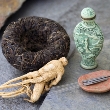Shakuyaku-kanzo-to
Shakuyaku-kanzo-to
Natural Standard Monograph, Copyright © 2013 (www.naturalstandard.com). Commercial distribution prohibited. This monograph is intended for informational purposes only, and should not be interpreted as specific medical advice. You should consult with a qualified healthcare provider before making decisions about therapies and/or health conditions.
Related Terms
Chinese herbal medicine, glycyrrhiza root, herbal medicine, licorice, Kampo, kanzo, peony root, shakuyaku, TCM, TJ 68, TJ-68, traditional Chinese medicine.
Background
Shakuyaku-kanzo-to is a Japanese herbal formula that is a part of the ever-evolving system of traditional Japanese medicine, called Kampo. A Kampo drug is a standardized and regulated multi-herb formula. Kampo formulas are an essential component of Japanese integrative medicine and are often given to patients alongside Western treatments in even the most mainstream of Japan's hospitals. Shakuyaku-kanzo-to is a Kampo formula made up of a blend of two crude drugs: shakuyaku (peony root) and kanzo (glycyrrhiza root, or licorice).
Due to its proposed effectiveness as a sedative, pain reliever and antispasmodic, shakuyaku-kanzo-to is prescribed in Japan to relieve calf cramps, menstrual and non-specific abdominal pain.
The herb is manufactured as prescription only in Japan by Tsumura®. The formula is usually taken by mouth in the form of capsules or tablets and the doses are higher than most Western medicines. Japanese patients often boil this formula into a tea. However, the smell and taste of such medication is not appealing to the palate of most Westerners. A qualified healthcare provider should be consulted before making decisions about therapies and/or health conditions.
Theory/Evidence
Shakuyaku-kanzo-to has been used in Japan and China for muscle pain and skeletal muscle tremors, arthralgia, numbness, peripheral neuropathy and dysmenorrhea.
Scientific studies suggest that shakuyaku-kanzo-to effectively reduces the severity of peripheral neuropathy, arthralgia (joint pain) and myalgia (muscular pain) and muscle cramps.
Safety
The U.S. Food and Drug Administration does not strictly regulate herbs and supplements. There is no guarantee of strength, purity or safety of products, and effects may vary. You should always read product labels. If you have a medical condition, or are taking other drugs, herbs, or supplements, you should speak with a qualified healthcare provider before starting a new therapy. Consult a healthcare provider immediately if you experience side effects.
Since shakuyaku kanzo-to consists of several herbs, it can potentially interact with other drugs, herbs or supplements. Therefore, a qualified healthcare provider should be consulted before making decisions about therapies and/or health conditions. Avoid if pregnant or breastfeeding.
Author Information
This information has been edited and peer-reviewed by contributors to the Natural Standard Research Collaboration (www.naturalstandard.com).
Bibliography
Natural Standard developed the above evidence-based information based on a thorough systematic review of the available scientific articles. For comprehensive information about alternative and complementary therapies on the professional level, go to www.naturalstandard.com. Selected references are listed below.
Fujii K, Okamoto S, Saitoh K, et al. [The efficacy of Shakuyaku-Kanzo-to for peripheral nerve dysfunction in paclitaxel combination chemotherapy for epithelial ovarian carcinoma] [Article in Japanese.] Gan To Kagaku Ryoho. 2004 Oct;31(10):1537-40. View Abstract
Hasegawa K, Mizutani Y, Kuramoto H, et al. [The effect of L-Glutamine and Shakuyaku-Kanzo-to for paclitaxel-induced myalgia/arthralgia] [Article in Japanese.] Gan To Kagaku Ryoho. 2002 Apr;29(4):569-74. View Abstract
Natural Standard: The Authority on Integrative Medicine. www.naturalstandard.com
Copyright © 2013 Natural Standard (www.naturalstandard.com)
The information in this monograph is intended for informational purposes only, and is meant to help users better understand health concerns. Information is based on review of scientific research data, historical practice patterns, and clinical experience. This information should not be interpreted as specific medical advice. Users should consult with a qualified healthcare provider for specific questions regarding therapies, diagnosis and/or health conditions, prior to making therapeutic decisions.
Updated:
March 22, 2017
